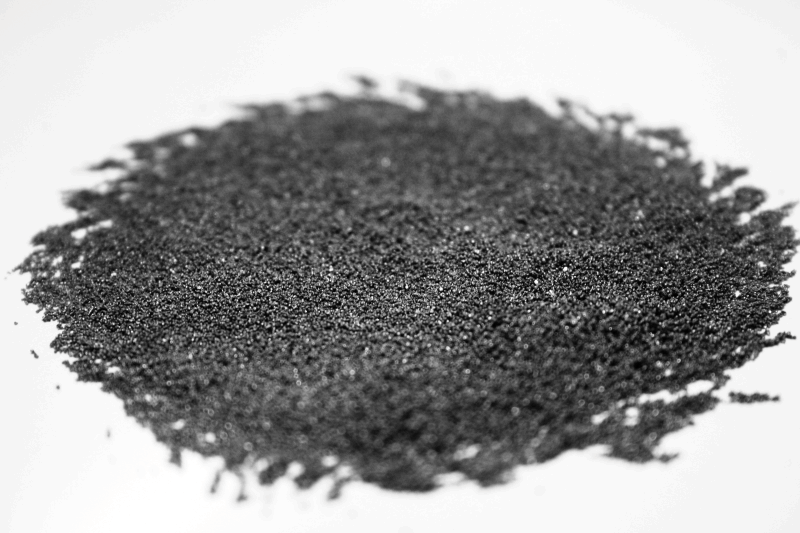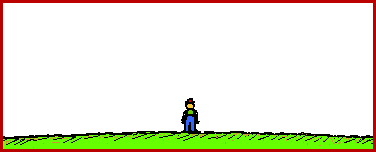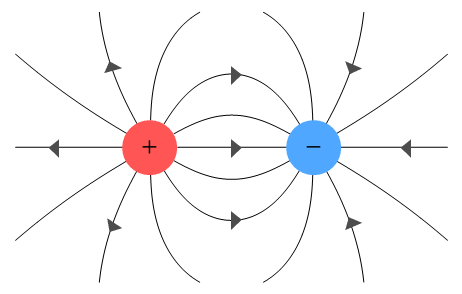
The 'Electro' Part
In order to be able to control magnetism, we need to understand what makes things magnetic. As magnetism and electricity are so closely related, a whole branch of physics is dedicated to understanding the interactions of the two phenomena - we call this branch electromagnetism. In fact, magnetic fields are created by the movement of charge, and electricity is the flow of charge!
What is Charge?
If you want to understand what makes something magnetic, you need to know a little bit about electricity - the thing that 'come' from power point and powers devices, such as the one you're using to see this website. Electricity is caused by the movement or flow of charge (The University of Wisconsin-Madison 2018). You've probably heard this word before and associate it with electricity, you might say that you 'charge' your phone. Charge is an intrinsic property of an object - just like people have skin or a bike has wheels, some things have charge (The University of Wisconsin-Madison 2018). Just like magnetic poles, charged things only interact with other charged things, and they can interact with each other from a distance (The University of Wisconsin-Madison 2018). Also, just like magnetic poles, we say that their are two types of charge: positive charge and negative charge (The University of Wisconsin-Madison 2018). You may remember these charges from when you studied the atom - electrons are negatively charged and protons are positively charged.

(Sparkfun Electronics 2013)
What Does Charge Do?

Tesla coils use electricity (Miranda 2016).
We represent positive charge with the plus symbol (+) and negative charge with the minus symbol (-) (The University of Wisconsin-Madison 2018). Like magnetic poles, like-charges repel (push each other away) and opposite charges attract (The University of Madison-Wisconsin 2018). We call these electrostatic forces (New York University 2001). Because of this interaction between charges, objects with charge can have potential energy depending on how close they are to other things with charge (if two like charges are close together, they'll push each - we call this electrical potential energy (Boston University 2011).
As with any object, charged objects can also have kinetic energy, or energy they have because they're moving (Boston University 2011). When we say that electricity is the flow of charge, what we mean is that it converts electrical potential energy into kinetic energy (the movement of charges), which we can use for things like making light-bulbs glow (Boston University 2011).
Can We Add Charge?
In year 9, you'll discover that everything, (even people) is made of differently charged particles (people are made from atoms, which contain protons and electrons, which are charged) (New York University 2001). The reason you aren't physically attracted or repelled from other people is that charge can 'cancel out' (New York University 2001). When two things that have opposite charges (one of them has a negative charge and the other has a positive charge), but both have equal amounts of charge, are placed together, their charges 'cancel out' - so, the thing that they make when they are together doesn't have any charge (we call this the net (total) charge; New York University 2001). You can learn about how magnetic fields can also 'cancel out' on the Transformers page. Imagine that you're playing tug-of war with your friend, but they pull back with the same amount of force as you do - neither one of you, or the rope would move!

(The University of Minnesota Twin Cities 2011)
So How does this Relate to Magnetism?

We call the little magnetic fields inside things magnetic domains (Nave 2017). This diagram shows magnetic domains in non-magnetised materials (Aspencore, Inc 2018).

This diagram shows magnetic domains in magnetised materials (Aspencore, Inc 2018).
Even though the charges in most things (even magnetic materials, such as iron) 'cancel out', and so they (the objects) don't experience any net forces caused by charge, a weird thing happens when charges move (New York University 2001). When charges move relative to each other (this means if you were one charge, you would see the other one moving - ask your teacher if you need help!), a magnetic force between the charges is created (New York University 2001). Moving charges cause magnetism (New York University 2001).
Even though you can't see anything moving in magnetic materials, there are little charged things (electrons) that are constantly moving, and consequently create their own magnetic fields (New York University 2001). In most materials, these little magnetic fields 'cancel out' (New York University 2001).
In magnetic materials, these little magnetic fields align with each other and add together (New York University 2001). This makes a total or net magnetic field, and is what makes an object magnetic (New York University 2001). This is also why metals like iron, which can be permanent magnets, need to be initially magnetised (New York University 2001).
So What Makes Something Magnetic?
As magnetic fields interact with each other (like poles repel and opposite poles attract), the direction of the magnetic fields created by moving electrons can be changed by putting another magnetic field through a material that can be magnetised (such as iron) (The Non-Destructive Testing Resource Center 2003). This can be done by simply placing a magnet next to a material that can be magnetised (The Non-Destructive Testing Research Center 2003); the strength of the magnet determines how many domains (little magnetic fields within materials created by the alignment of the magnetic fields of electrons that are near each other) in the magnetisable material align with the external magnetic field (a magnetic field applied to something), and how strong the resulting magnetic field will be (The University of California, Berkely 2005).

Imagine that all magnets are made of lots of tiny little magnets, like iron filings (above). When another magnet moves close to them, they all move to point in the direction it's pointing, and attract it (this only happens in ferromagnets) (The Non-Destructive Testing Resource Center 2005). Image: (Jones 2014).

Materials that 'allow' most of their magnetic domains to align together so that they are attracted to another magnetic object are called ferromagnetic materials (The University of Minnesota 2002). Ferromagnetic materials will keep this alignment, and become permanent magnets (The University of Minnesota 2002). These materials have high magnetic susceptibilities, which means that they produce a relatively strong magnetic field when an external magnetic field is going through them (The University of Minnestoa 2002).
Permanent magnets, like bar magnets, are ferromagnetic (Motovilova et al. 2017). Image: (Rainbow Resource Center, Inc 2018).
What About Things That Just Aren't Magnetic?
There are also some materials that don't allow the magnetic fields of their electrons to align together so as to attract other magnet, but align the magnetic fields of their electrons to create no net magnetic field (they don't have a total magnetic field, because all the 'little ones' cancel out; Motovilova et al. 2017). We call these things anti-ferromagnetic materials (The University of Minnesota 2002). Anti-ferromagnetic aren't attracted to or repelled by other magents (Motovilova et al. 2017)
Other non-magnetic materials just don't have any domains - the magnetic fields of each of the electrons in them point in random directions (so they cancel each other out) and aren't aligned together by an external magnetic field (The University of Minnesota 2002).

This diagram shows the directions of the magnetic fields of electrons that are next to each other in antiferromagnetic materials (Motovilova et al. 2017) Notice that they oppose each other to create no net magnetic field (Motovilova et al. 2017).

There are also some materials (like the paperclips discussed on The 'Magnet' Part page) that will be attracted to magnetic objects when they are in a magnetic field, but are otherwise not magnetic (The University of Minnesota 2002). These are paramagnetic materials (The University of Minnesota 2002). In paramagnetic materials, there aren't any domains, and most of the magnetic fields produced by the electrons surrounding each atom will always cancel each other out, because they have to be arranged in pairs with opposite spins (this is called the Pauli Exclusion Principle; Motovilova et al. 2017). But wait - you can't divide odd numbers of things into pairs!
You can try this experiment with some string, magnets and paperclips (Buggy and Buddy 2018).
The magnetic fields of these unpaired electrons don't have to cancel each other out, but they usually do - this is because they are usually arranged randomly and aren't strong enough to change each other's direction (Motovilova et al. 2017). When a magnetic field comes 'near' them, they are all 'pulled' towards it - so paramagnetic materials become magnetic when they are 'in' relatively strong magnetic fields (Motovilova et al. 2017). When the 'strong' magnetic field is taken away, they go back to being randomly arranged (Motovilova et al. 2017).

Oxygen is paramagnetic: notice how it has two unpaired electrons (Sullivan 2012). Image: (Elektronik.us 2018).
How Does Movement of Charge Create Magnetic Fields?
According to Albert Einstein's theory of relativity (a picture of him is shown on the right, just in case you've never heard of him), the length of different things and the distances between them change depending on whether they are moving or not (Schroeder 1999). We call this phenomenon length contraction (The University of British Columbia 2009). This means that the density, or amount of charge in one location, can change depending on how the charge is moving (Schroeder 1999). As a consequence, even if something is electrically neutral (has an even and balanced distribution of positive and negative charge), movement of charge inside it (from the 'perspective' of a different charged thing outside it) makes this distribution of charge change, but only from the 'perspective' of the other charged thing (Schroeder 1999).

Just a guy you may have heard of before: Albert Einstein (Christensen 2017).
Fun Fact
Electrons create two different magnetic fields around themselves which 'add' together to form one net magnetic field. Their motion around atoms creates one magnetic field, and their spin creates another!
(The Non-Destructive Testing Resource Center 2001)
For example, electrons may move at a certain speed, causing the distance between them to contract, with results in an increased density of negative charge in that area (The University of British Collumbia 2009) As charges repel or attract each other (depending on what they are), this causes the charged object to be attracted to or repelled from the electrically neutral object, that contains the moving charge (Schroeder 1999). This force is the force of magnetism. As magnetism is caused by this contraction of this distance between charged particles, the magnetic force only exists between moving charged particles (Schroeder 1999).
Length Contraction

GIF of a slow-moving rocket, from the perspective of an observer (The Physics Classroom 2018).

GIF of a fast-moving rocket, from the perspective of an observer (The Physics Classroom 2018). Check out how its length has contracted!

What Does This Tell Us About Magnetism?
As magnetism is essentially a name we give to the electrostatic force (force between charged particles) that arises between moving charged particles (like protons and electrons), magnetic fields interact with other magnetic fields in almost the same way that electric fields interact with other electric fields (Duffy 2010). We even represent both fields using field lines (Duffy 2010)!
Diagram of Electric Field Lines (Coker 2015).
This also means that everything that has electricity flowing through it makes a magnetic field (The Non-Destructive Testing Resource Center 2002)! The faster electricity is flowing, the stronger the magnetic field produced (this is because length contraction is dependent on speed; Nave 2017). We also have a special rule for determining the direction of a magnetic field produced by a wire with electricity flowing through it; if you make a fist with your fingers and point your thumb in the direction of flow of positive charge, your fingers will point in the direction of the magnetic field (it will make circles around the wire; Nave 2017). We call this the right hand grip rule (Princeton University 2012).

The right-hand grip rule (Princeton University 2012). Always remember that the thumb points in the direction of movement of positive charge (Princeton University 2012). Note that positive charge would move away from the positive sign, towards the negative sign (Princeton University 2012).
I thought You Said That Only Negative Charge Could Move In Most Materials ...

Diagram of Conventional Current (Hedberg 2017). Note that electrons are negatively charged particles.